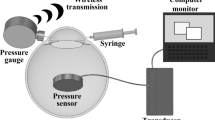Abstract
• Background: For certain special investigations, particularly in glaucoma diagnostics, intraocular pressure has to be increased. Mostly, a suction cup apparatus is used for that purpose. These devices, however, have some disadvantages. They are at least uncomfortable, sometimes risky for the patient and induce a strong astigmatism which can influence the results of the corresponding investigation.
• Method: Avery simple mechanical device has been constructed and tested, by means of which the intraocular pressure can be increased for diagnostic purposes. A ring on a lever, which is moved towards the eye by small weights, compresses the eye through the lids without the need of even local anesthetics. The device can be easily mounted to any head fixation which is normally used in combination with ophthalmological equipment, e.g. slit lamp, visual field analyzer or fundus camera. Tests have been performed in four different groups: one group of 19 healthy volunteers, one of 21 patients with Graves' disease, one of 21 patients with high myopia and one of 20 patients with open-angle glaucoma.
• Results: Pressure elevations could be achieved in all patients with very good reproducibility with respect to the applied forces. However, in patients with exophthalmos (Graves' disease), the elevation effect was somewhat higher than in normal eyes. The induced astigmatism was only about 0.5 dpt for pressure elevations of about 20 mmHg.
• Conclusion: The tests performed showed that the new device is easy to handle and comfortable for the patients. If very high accuracy is needed concerning the pressure values achieved, an individual calibration should be performed.
Similar content being viewed by others
References
Baillard P (1917) La pression artérielle dans les branches de l'artére centrale de la rétine; nouvelle technique pour la déeterminer. Ann Oculistique l: 648–666
Benedikt O, Bard G, Hiti H, Mandl H (1974) Die Änderung der elektrophysiologischen Antwort am menschlichen Auge bei kurzzeitiger Erhöhung des Augeninnendruckes. Graefe's Arch Klin Exp Ophthalmol 192: 57–64
Bernd A, Ulrich WD, Teubel H, Rohrwacher F, Barth T (1992) Refraction changes during elevation of intraocular pressure by suction cup, their reflection in the pattern visual evoked potential, and their compensation. Doc Ophthalmol 83: 151–162
Dielemans I, Vingerling JR, Hofman A, Grobbee DE, de Jong PTVM (1994) Reliability of intraocular pressure measurements with the Goldmann applanation tonometer in epidemiological studies. Graefe's Arch Clin Exp Ophthalmol 232: 141–144
Fox R, Blake R, Bourn JR (1973) Visual evoked cortical potentials during pressure blinding. Vision Res 13: 501–503
Freyler H (1985) Augenheilkunde. Springer, Vienna New York, pp 24–25
Grounauer PA, Van Toi V, Streiff EB (1980) Ophthalmodynamographie pneumatique an biomicroscope. Klin Monatsbl Augenheilkd 176: 619–624
Heider W (1987) Computerperimetrische Bestimmung der Drucktoleranz des vorderen Sehnervsegmentes bei Glaukompatienten. Fortschr Ophthalmol 84: 587–591
Kukán F (1936) Ergebnisse der Blutdruckmessungen mit einem neuen Ophthalmodynamometer. Z Augenheilkd 90: 166–191
Lindberg JG (1935) Experimentelle Untersuchungen über den Blutdruck in den retinalen Venen des Kaninchens bei erhöhtem Gehirndruck. Graefe's Arch Klin Exp Ophthalmol 133: 191–210
Müller HK, Brüning A, Sohr H (1937) Die Eichung des Dynamometers von Baillard-Sobanski am menschlichen Leichenauge. Acta Cone Ophthalmol 15: 54–60
Pillunat LE, Stodtmeister R, Wilmanns I, Christ T (1986) Drucktoleranztest des Sehnervenkopfes bei okulärer Hypertension. Klin Monatsbl Augenheilkd 186: 39–44
Rohrwacher F, Bernd A, Ulrich Ch, Teubel H, Barth Th, Ulrich WD (1994) Einfluß der Refractionsänderung bei Erhöhung des Augeninnendruckes mit der Saugnapfmethode auf das Pattern-reversal-VECP. Ophthalmologe 91: 185–190
Schiefer U, Wilhelm H, Zrenner E, Aulhorn E (1991) Beeinflussung von Refraction und Rauschfeldwahrnehmung durch Saugnapfokulokompression. Fortschr Ophthalmol 88: 522–529
Schiefer U, Ulrich WD, Ulrich C, Wilhelm H, Aulhorn E (1992) Rauschfeld-Kampimetrie vor und während künstlicher Augeninnendrucksteigerung — Einsatzmöglichkeiten in der Glaukomdiagnostik. Ophthalmologe 89: 477–488
Schiefer U, Ulrich Ch, Ulrich WD, Petzel C, Bernd A, Wilhelm H (1994) Influence of suction cup oculopression on corneal astigmatism. Graefe's Arch Clin Exp Ophthalmol 232: 115–121
Stodtmeister R, Pillunat L, Mattern A, Polly E (1989) Die Beziehung zwischen negativer Druckdifferenz und künstlich erhöhtem Augeninnendruck bei der Saugnapfmethode. Klin Monatsbl Augenheilkd 194: 178–183
Van Toi V, Grounauer PA, Bruckhardt CW (1990) Artificially increasing intraocular pressure causes flicker sensitivity losses. Invest Ophthalmol Vis Sci 31: 1567–1574
Uyemura M, Suganumy S (1936) Über einen neuen Ophthalmodynamometer. Klin Monatsbl Augenheilkd 96: 481–494 Med Biol 12:279-288
Ulrich Ch, Ulrich WD (1987) OPT —Okulo-Pressions-Tonometrie zur Bestimmung der Abflußleichtigkeit und der Kammerwasserbildung des Auges. Ein Leitfaden für die Praxis. Thieme, Leipzig
Ulrich WD, Ulrich Ch, Petzel C, Nenning N, Barth Th (1993) Okulopressionstonometrie (OPT) in der Glaukompraxis. Ophthalmologe 90: 557–562
Wegner W (1925) Kann Skotombildung allein durch Erhöhung des intraokularen Druckes bedingt sein? Z Augenheilkd 56: 48–52
Author information
Authors and Affiliations
Additional information
This work contains parts of thesis of A. Duran
Rights and permissions
About this article
Cite this article
Preu\ner, PR., Duran, A. New device for artificial increasing intraocular pressure. Graefe's Arch Clin Exp Ophthalmol 234, 683–687 (1996). https://doi.org/10.1007/BF00292354
Received:
Revised:
Accepted:
Issue Date:
DOI: https://doi.org/10.1007/BF00292354



